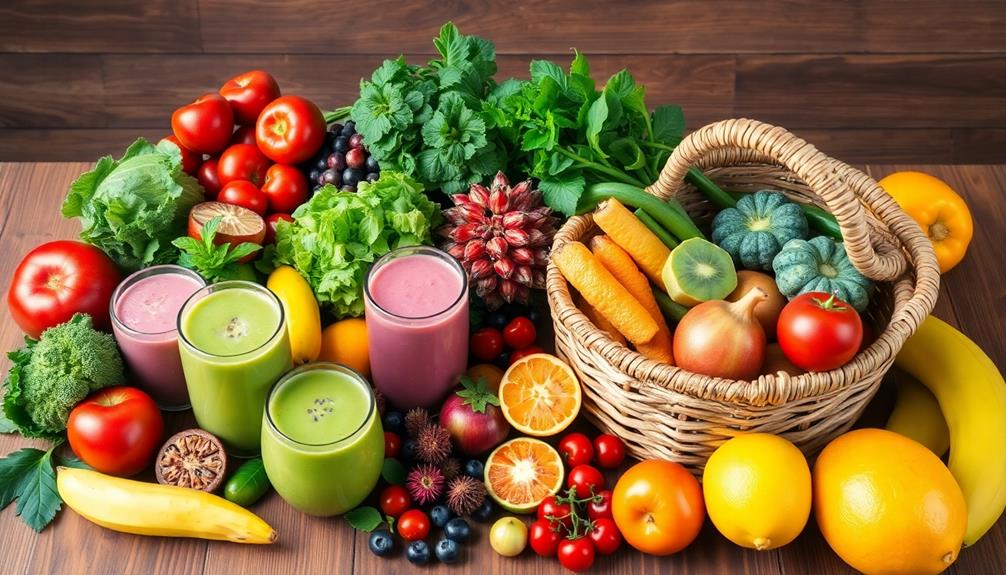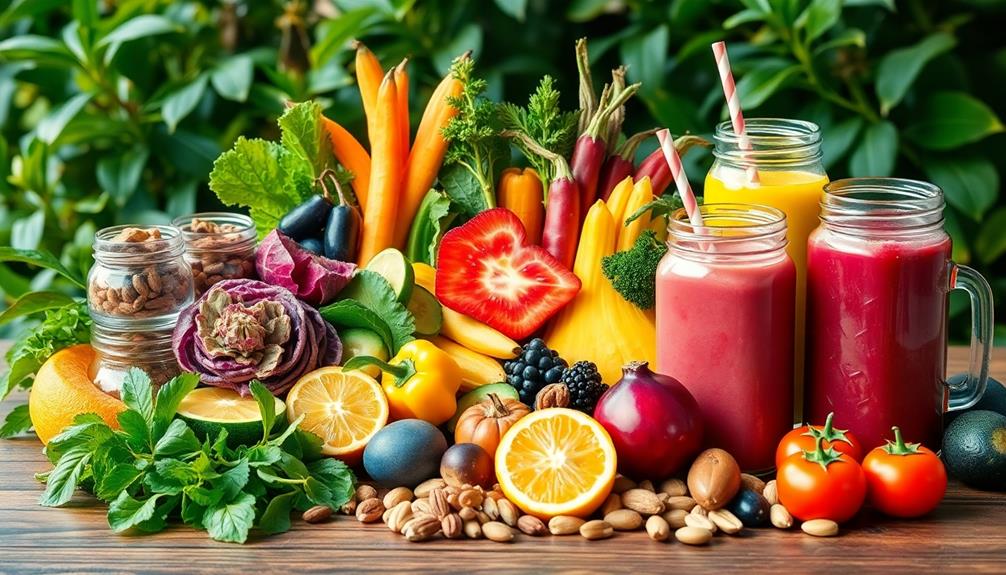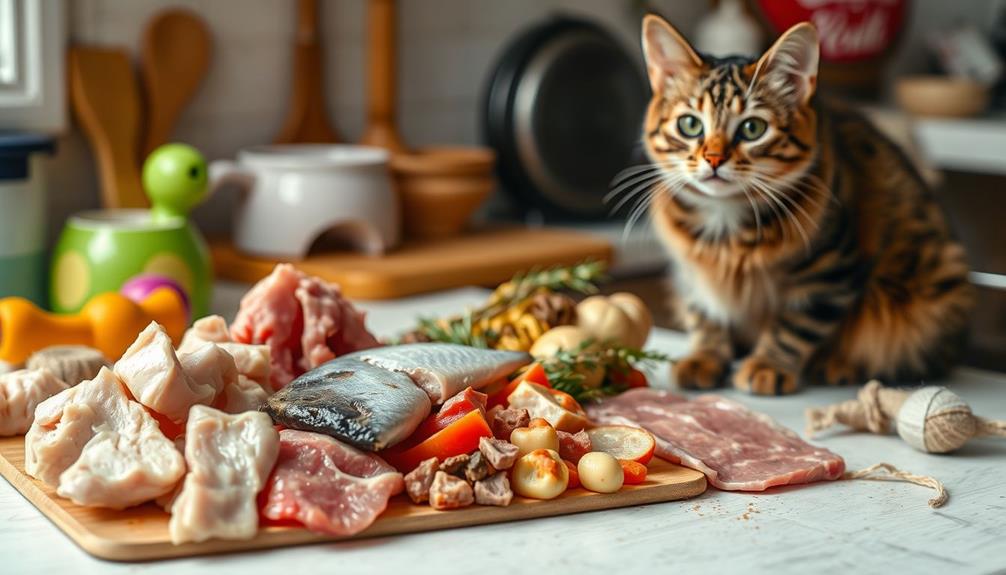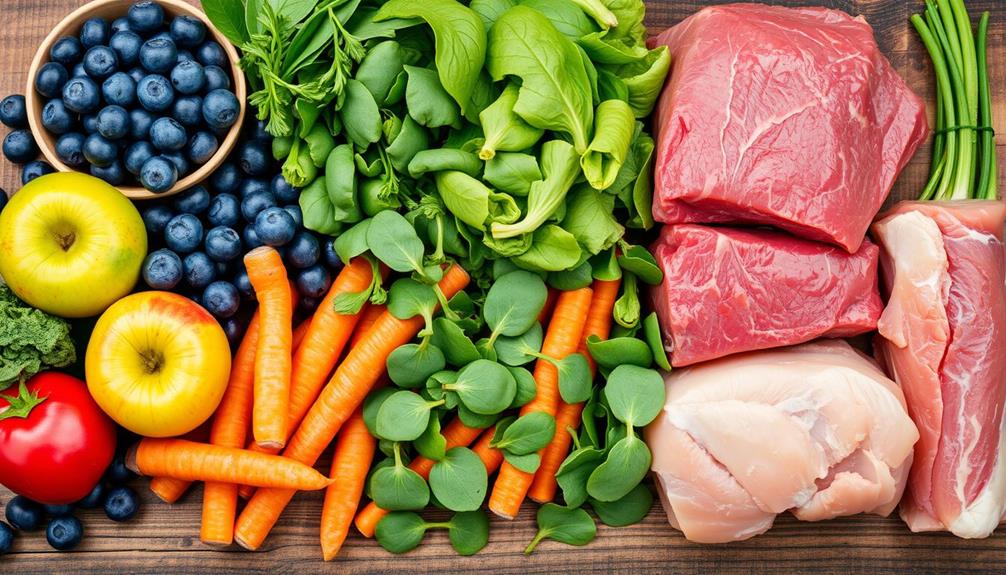A one-week raw food meal plan makes it easy for you to enjoy fresh, vibrant meals without cooking. Start your day with chia pudding topped with berries, followed by a hearty salad or wrap for lunch. Snack on raw nuts or dried fruits, and for dinner, try veggie noodles with a light dressing or stuffed avocados. Don't forget to hydrate! For your shopping list, include fresh fruits like apples and watermelon, raw veggies like cucumbers and leafy greens, plus nuts and seeds for healthy fats. There's plenty more to explore for your raw food journey ahead.
Key Takeaways
- A one-week raw food meal plan includes breakfast, lunch, snacks, and dinner featuring fruits, vegetables, nuts, and seeds for balanced nutrition.
- Incorporate a variety of seasonal produce to enhance flavors, textures, and nutrient density throughout the week.
- Prepare meals such as chia pudding, vibrant salads, and veggie noodles to maintain excitement and creativity in your diet.
- Create a shopping list with essentials like fresh fruits, raw vegetables, nuts, seeds, and plant-based milk for easy meal preparation.
- Consider budgeting tips like buying in bulk and shopping at local farmers' markets to reduce costs and ensure freshness.
Overview of Raw Food Diet
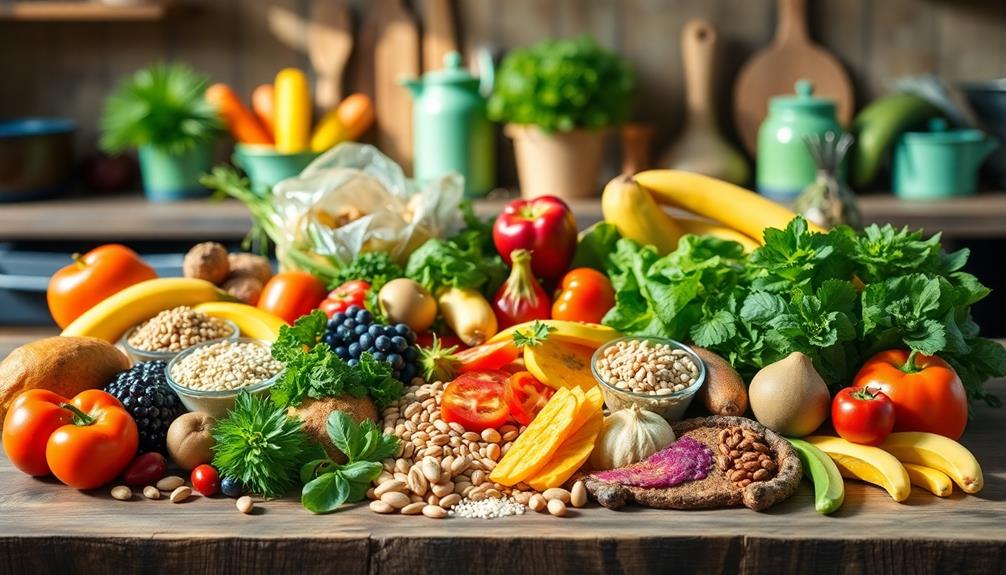
The raw food diet is all about embracing nature's bounty by focusing on uncooked and unprocessed plant-based foods. This approach encourages you to enjoy a variety of fruits and vegetables, nuts and seeds, and sprouted grains, maximizing your nutrient intake. By keeping foods below 118°F, you preserve the essential enzymes and nutrients often lost in cooked or processed foods.
When you adopt a raw food diet, you're not just changing what you eat; you're promoting improved digestion, increased energy, and a lower risk of chronic diseases like heart disease and diabetes.
However, a well-planned raw food diet requires careful attention to guarantee you get enough protein, essential fatty acids, vitamins, and minerals. You might even consider supplements like Vitamin B12 to fill any gaps.
Creating your meal plans can be a fun, creative process. You'll discover various textures and colors while experimenting with raw ingredients, making your meals enjoyable and diverse.
Foods to Include
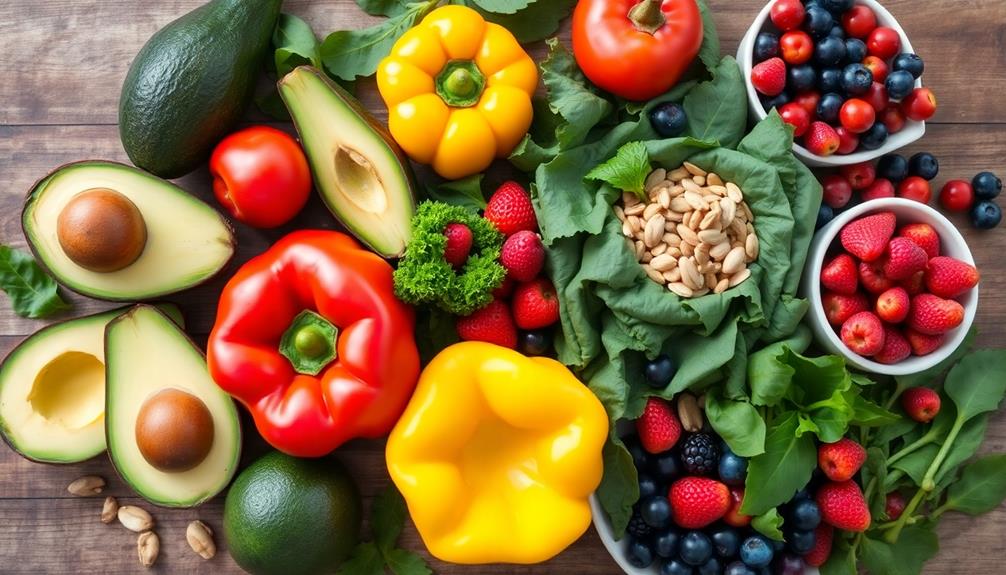
A successful raw food meal plan hinges on including a diverse array of fresh, unprocessed ingredients that nourish your body. Start with fresh fruits like berries, apples, oranges, and watermelon. These fruits are packed with vitamins, antioxidants, and natural sugars to give you energy throughout the day.
Adding herbal teas to your routine can also enhance your wellness, as they provide health benefits like digestion aid.
Next, incorporate raw vegetables such as leafy greens, cucumbers, tomatoes, carrots, and bell peppers. They enhance your fiber intake and provide essential vitamins and minerals.
Don't forget to add nuts and seeds to your meals! Almonds, walnuts, sunflower seeds, chia seeds, and flaxseeds are excellent sources of healthy fats, protein, and important micronutrients.
For quick and easy snacking, choose raw vegan snacks like energy bars, dried fruits, and dehydrated vegetables. These nutrient-packed options are perfect for when you're on the go.
Foods to Avoid
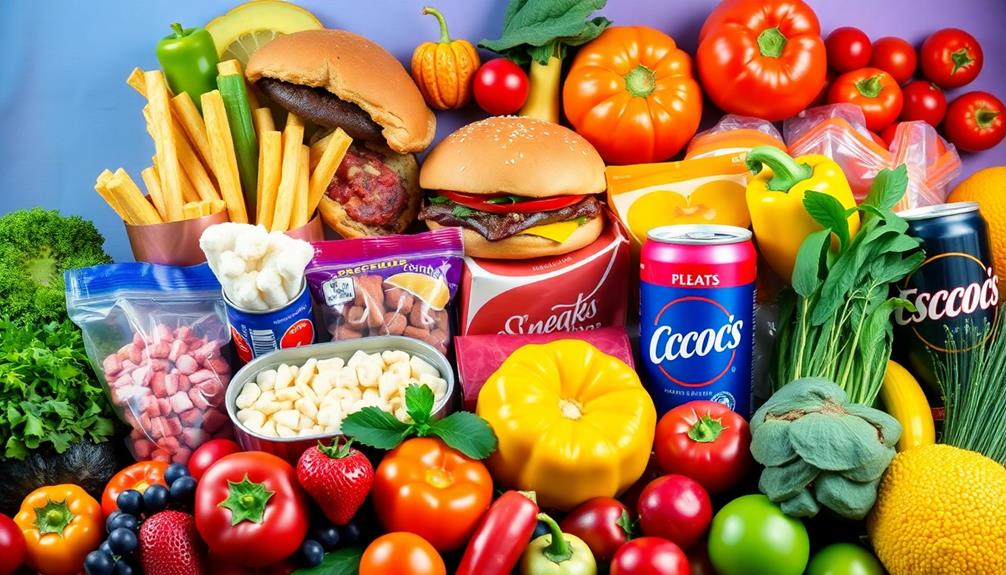
When following a raw food diet, you need to be mindful of certain foods that can pose health risks and lead to nutritional deficiencies.
Avoiding cooked foods, processed snacks, and animal products is essential, as these can compromise your health and well-being.
Health Risks Involved
Maneuvering a raw food diet requires awareness of certain health risks, particularly related to nutrient deficiencies and food safety. If you're not carefully planning your meals, you could face significant health risks. For instance, excluding cooked foods can lead to a lack of protein, calcium, vitamin B12, and iron, which are essential for your body.
Moreover, the raw food diet prohibits processed snacks, refined sugars, and animal products, limiting your dietary variety and necessary nutrients.
It's also important to guarantee you're avoiding caffeine and alcohol, as these can hinder your hydration and overall well-being.
Another serious concern is foodborne illness; improperly handled raw foods can harbor bacteria or parasites, increasing your risk of contamination.
To mitigate these dangers, it's wise to consult a registered dietitian before diving into a raw food diet, especially if you have specific dietary needs or health conditions.
Nutritional Deficiencies Concerns
Following the discussion on health risks, it's important to recognize specific nutritional deficiencies that can arise from a raw food diet. One major concern is vitamin B12, which is primarily found in animal products. Without supplementation or fortified foods, you risk serious deficiency.
Additionally, protein intake can drop considerably on a raw vegan diet, often falling to around 20g per day. This is generally insufficient, especially for those with higher protein needs.
Calcium is another essential nutrient that can be challenging to obtain without dairy; prioritize leafy greens and fortified plant-based milks to help meet your requirements.
Iron is important for energy levels, but absorption may be hindered due to phytates in grains and legumes. Incorporating vitamin C-rich foods, like citrus fruits and bell peppers, can enhance iron absorption and support your overall health.
Being aware of these nutritional deficiencies is key to maintaining a balanced diet. By addressing these concerns, you can enjoy the benefits of a raw food diet while minimizing potential health risks.
Always consider incorporating supplements or fortified foods to guarantee you're meeting your nutritional needs effectively.
Health Benefits
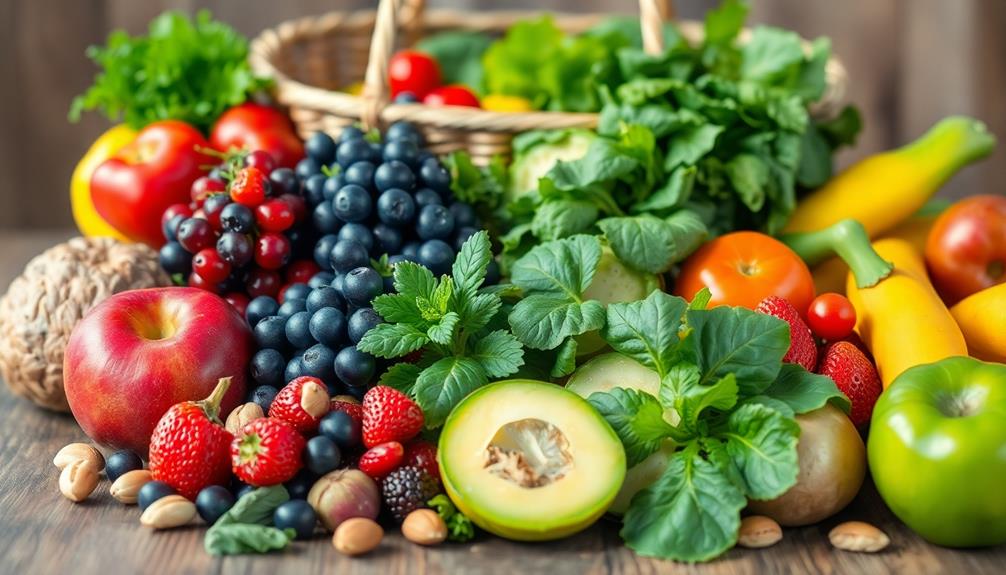
When you embrace a raw food diet, you're boosting your nutrient intake with antioxidant-rich foods that enhance your overall energy.
This diet emphasizes whole, unprocessed foods, which can lead to health benefits such as increased energy and improved digestion.
The high fiber content in raw fruits and vegetables can improve your digestive health, keeping your gut happy and reducing gastrointestinal issues.
Plus, the increased nutrient density can lead to better energy levels and mental clarity, making you feel your best every day.
Nutrient Density Increase
A raw food diet, packed with vitamins, minerals, and enzymes, greatly boosts nutrient density, enhancing your overall health. By focusing on raw foods, you'll consume higher levels of antioxidants than you'd with cooked meals. This increase in nutrient density supports your body's functions, helping you maintain ideal energy levels throughout the day.
Raw fruits and vegetables are also rich in fiber, which can greatly improve your fiber intake. This not only aids in weight management—allowing you to feel fuller on fewer calories—but it also reduces the risk of chronic diseases like heart disease and diabetes.
The low-calorie nature of raw foods means you can enjoy satisfying meals without compromising your health goals. Moreover, the high water content of these foods keeps you hydrated, which is crucial for overall well-being and enhances skin health.
You'll find that adopting a raw food diet is a delicious way to nourish your body with essential vitamins and minerals while promoting a vibrant lifestyle. Embracing this approach may just be the key to transforming your energy levels and achieving lasting wellness.
Digestive Health Improvement
One of the standout benefits of a raw food diet is its significant impact on digestive health. By focusing on whole foods, you're not only fueling your body with essential nutrients but also enhancing your digestive system's performance. This diet is high in fiber, thanks to the abundant fruits and vegetables you'll consume. Increased fiber intake promotes regular bowel movements and helps prevent constipation, keeping your digestive tract running smoothly.
Moreover, raw foods are packed with natural enzymes that assist in breaking down food, improving nutrient absorption. These enzymes work best when fruits and vegetables are consumed uncooked, directly aiding digestion.
Additionally, the high water content in raw foods helps to keep your digestive system hydrated, which is vital for overall gastrointestinal health.
A diet rich in whole, unprocessed foods minimizes the intake of additives and preservatives, which can irritate your digestive tract and lead to discomfort. Studies have shown that eating more fruits and vegetables lowers the risk of developing digestive disorders like diverticulitis and irritable bowel syndrome (IBS).
Embracing a raw food diet can truly transform your digestive health for the better.
Antioxidant-Rich Foods
Focusing on raw foods not only boosts your digestive health but also introduces a wealth of antioxidant-rich options that can greatly benefit your overall well-being. Incorporating foods like berries, leafy greens, and nuts into your diet helps combat oxidative stress, potentially reducing the risk of chronic diseases such as heart disease and cancer.
Antioxidant-rich fruits and vegetables, including tomatoes and carrots, are particularly beneficial for your skin and eyes. They protect against UV damage, enhancing your skin's elasticity and hydration, while carotenoids may lower the risk of age-related macular degeneration.
Moreover, a diet high in antioxidants supports your immune function, improving your body's ability to fend off infections and illnesses.
You'll also find that consistently consuming these foods can enhance cognitive function and reduce the risk of neurodegenerative diseases like Alzheimer's.
Budgeting Tips
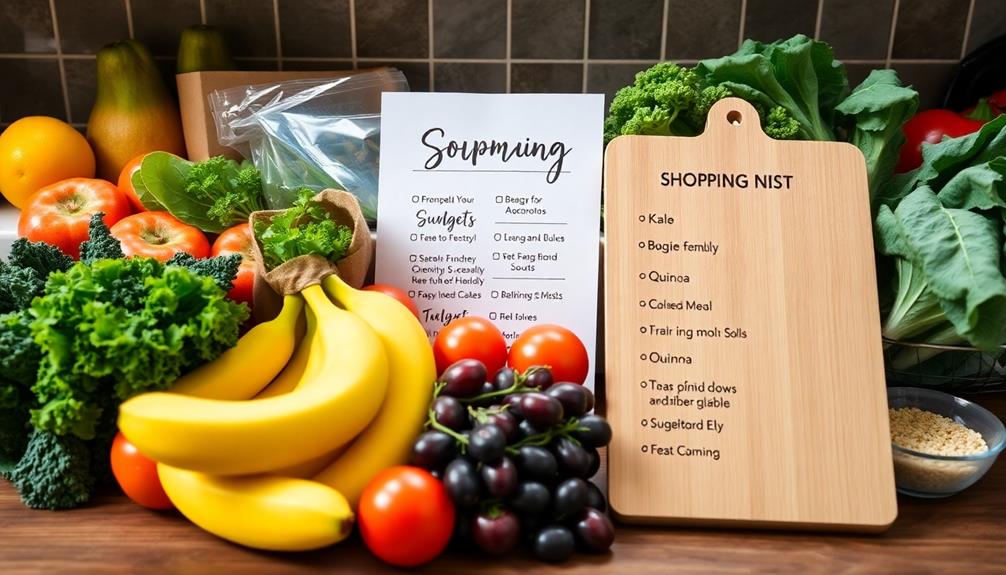
Effective budgeting for a raw food diet can be achieved with a few smart strategies. Start by creating a shopping list based on seasonal produce, which is fresher and often cheaper. Buying in bulk can also greatly reduce costs for staple ingredients like nuts, seeds, and dried fruits. Plus, consider shopping at local farmers' markets for lower-priced fresh fruits and vegetables compared to conventional grocery stores.
Here's a quick guide to help you with your budgeting:
| Strategy | Benefits | Tips |
|---|---|---|
| Buy in bulk | Reduces costs for staples | Look for bulk bins at your store |
| Choose seasonal produce | Guarantees freshness and affordability | Check local market calendars |
| Shop local farmers' markets | Access to lower prices | Visit early for the best selection |
| Plan meals around sales | Maximizes nutrient intake | Check store flyers weekly |
| Make homemade alternatives | Cuts costs on packaged items | Try making nut milk or energy bars |
7-Day Meal Plan
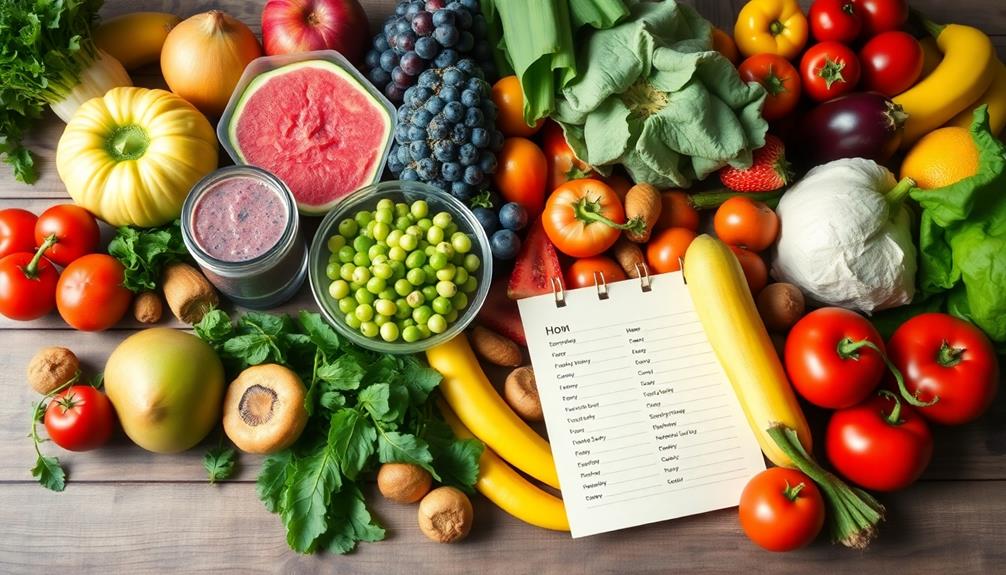
Planning a raw food meal plan for the week can be both exciting and rewarding. A well-structured day guarantees you enjoy diverse nutrients while staying energized.
Here's a simple outline to get you started on your raw vegan diet:
- Breakfast: Kick off your day with a delicious chia pudding topped with fresh fruits.
- Lunch: Create a vibrant salad or wrap filled with seasonal veggies and a sprinkle of nuts and seeds for added crunch.
- Snack: Keep your energy up with raw nut mixes or some dried fruits.
- Dinner: Enjoy a satisfying plate of veggie noodles tossed in a light dressing or stuffed avocados for a filling meal.
Don't forget about hydration throughout the day. Raw foods contain high water content, which supports digestion and overall wellness.
As you build your shopping list, focus on seasonal produce and bulk nuts and seeds to maximize freshness and affordability.
Shopping List Essentials
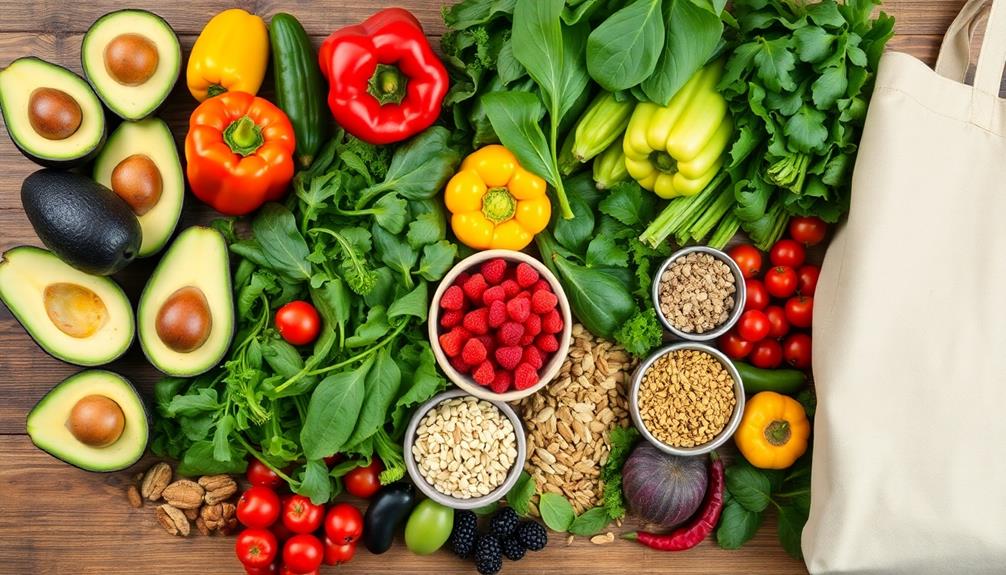
Creating a well-rounded shopping list is essential for your raw food meal plan. Start with fresh fruits like berries, apples, and watermelon to maximize your nutrient intake. Next, include a variety of raw vegetables such as leafy greens, cucumbers, and bell peppers. Don't forget to add nuts and seeds, which are excellent protein sources and healthy fats.
To make your shopping easier, consider the following essentials:
| Category | Items |
|---|---|
| Fresh Fruits | Berries, Apples, Watermelon |
| Raw Vegetables | Leafy Greens, Cucumbers, Bell Peppers |
| Nuts and Seeds | Almonds, Walnuts, Chia Seeds |
| Plant-Based Milk | Almond Milk, Coconut Milk |
Buying seasonal produce not only saves you money but also guarantees you get the freshest ingredients. For snacks, consider dried fruits and dehydrated vegetables that fit the raw food philosophy. Finally, stock up on plant-based milk and protein powders for easy meal preparation, guaranteeing variety throughout the week. Happy shopping!
Frequently Asked Questions
How Do I Plan a One Week Menu?
To plan a one-week menu, start by selecting diverse meals that include fresh ingredients. Incorporate seasonal produce, and allocate days for meal prep. Create a shopping list to guarantee you have everything you need.
What Is the 80 20 Raw Food Diet Plan?
The 80/20 Raw Food Diet Plan lets you enjoy 80% raw, unprocessed foods while allowing 20% cooked options. This balance maximizes nutrition, promotes digestive health, and keeps meal preparation fun and flexible for your lifestyle.
Which Two Food Groups Are Missing From the Rawtarian Meal Plan?
The two food groups missing from the Rawtarian meal plan are whole grains and legumes. By not including these, you might miss out on essential carbohydrates, protein, and a wider range of nutrients for ideal health.
What Is the Diet Where You Eat Everything Raw?
You're referring to the raw food diet, where you eat uncooked, unprocessed foods like fruits, vegetables, nuts, and seeds. This approach aims to maximize nutrient intake while promoting better digestion and overall health.
Conclusion
Embracing a raw food diet can be both invigorating and challenging. You'll discover vibrant flavors while saying goodbye to processed options that often leave you feeling sluggish. As you explore this one-week meal plan, you'll find nourishment in simple, whole ingredients that energize your body and mind. Remember, balance is key; indulge in the joy of fresh produce while maintaining a mindful approach to your health. Immerse yourself and savor the transformation that awaits!

